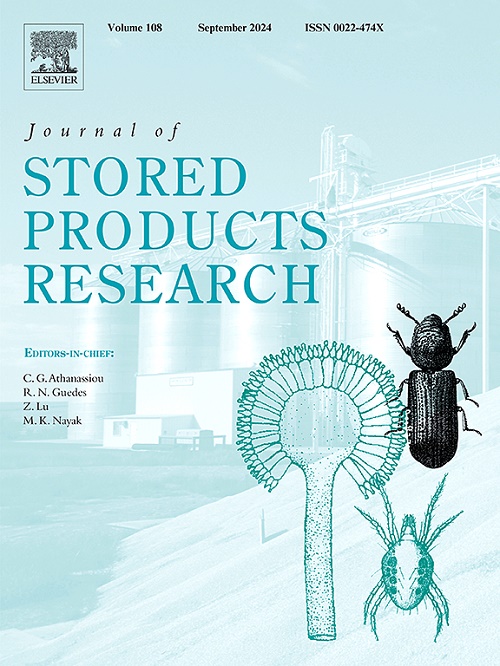Chemical compositions and insecticidal activities of Tetradium ruticarpum essential oils against Lasioderma serricorne
IF 2.7
2区 农林科学
Q1 ENTOMOLOGY
引用次数: 0
Abstract
Stored products are susceptible to insect infestation. Many plant essential oils (EOs) have been used to control various pests, and compared to conventional pesticides, these natural products generally pose lower risks to humans and the environment. This study aimed to evaluate the insecticidal and repellent properties of EOs extracted from Tetradium ruticarpum (formerly Euodia rutaecarpa) fruits at different collection times against Lasioderma serricorne. EOs were obtained through hydrodistillation and analyzed using gas chromatography-mass spectrometry (GC-MS). The oil yield was 1.18 v/w. A total of 41 compounds were identified, with monoterpenes dominating in most samples. Except for the TRF-7 sample, where the main compound was 1,3-dicyclohexylpropane (45.9%), the predominant compound in all other EOs was 3-carene, with contents exceeding 87%. According to Principal Component Analysis (PCA), the composition of TRF-7 EO differed significantly from the other EOs due to the different collection times. The bio-assays showed that EOs demonstrated strong contact toxicity and repellent effects against L. serricorne, but fumigant toxicity was relatively weak. Among the tested samples, TRF-2 and TRF-4 exhibited the highest contact toxicity, with LD50 values of 2.76 mg/L air and 4.08 mg/L air, respectively. Repellency was effective at higher concentrations but diminished with lower doses and extended exposure. These results suggest that EOs from T. ruticarpum fruits hold potential as botanical insecticides for protecting stored products.

求助全文
约1分钟内获得全文
求助全文
来源期刊
CiteScore
5.70
自引率
18.50%
发文量
112
审稿时长
45 days
期刊介绍:
The Journal of Stored Products Research provides an international medium for the publication of both reviews and original results from laboratory and field studies on the preservation and safety of stored products, notably food stocks, covering storage-related problems from the producer through the supply chain to the consumer. Stored products are characterised by having relatively low moisture content and include raw and semi-processed foods, animal feedstuffs, and a range of other durable items, including materials such as clothing or museum artefacts.

 求助内容:
求助内容: 应助结果提醒方式:
应助结果提醒方式:


